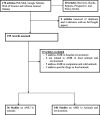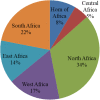Antimicrobial use and resistance in food-producing animals and the environment: an African perspective
- PMID: 32122406
- PMCID: PMC7053060
- DOI: 10.1186/s13756-020-0697-x
Antimicrobial use and resistance in food-producing animals and the environment: an African perspective
Abstract
Background: The overuse of antimicrobials in food animals and the subsequent contamination of the environment have been associated with development and spread of antimicrobial resistance. This review presents information on antimicrobial use, resistance and status of surveillance systems in food animals and the environment in Africa.
Methods: Information was searched through PubMed, Google Scholar, Web of Science, and African Journal Online databases. Full-length original research and review articles on antimicrobial use, prevalence of AMR from Africa covering a period from 2005 to 2018 were examined. The articles were scrutinized to extract information on the antimicrobial use, resistance and surveillance systems.
Results: A total of 200 articles were recovered. Of these, 176 studies were included in the review while 24 articles were excluded because they were not relevant to antimicrobial use and/or resistance in food animals and the environment. The percentage of farms using antimicrobials in animal production ranged from 77.6% in Nigeria to 100% in Tanzania, Cameroon, Zambia, Ghana and Egypt. The most antibiotics used were tetracycline, aminoglycoside and penicillin groups. The percentage of multi drug resistant isolates ranged from 20% in Nigeria to 100% in South Africa, Zimbabwe and Tunisia. In the environment, percentage of multi drug resistant isolates ranged from 33.3% in South Africa to 100% in Algeria. None of the countries documented national antimicrobial use and resistance surveillance system in animals.
Conclusion: There is high level of antimicrobial use, especially tetracycline, aminoglycoside and penicillin in animal production systems in Africa. This is likely to escalate the already high prevalence of antimicrobial resistance and multi drug resistance in the continent. This, coupled with weak antimicrobial resistance surveillance systems in the region is a great concern to the animals, environment and humans as well.
Keywords: Africa; Antimicrobial resistance; Antimicrobial use; Environment; Food animals; Surveillance.
Conflict of interest statement
The authors declare that they have no competing interests.
Figures
References
-
- Ilea RC. Intensive livestock farming: global trends, increased environmental concerns, and ethical solutions. J Agric Environ Ethics. 2009;22:153–167. doi: 10.1007/s10806-008-9136-3. - DOI
Publication types
MeSH terms
Substances
LinkOut - more resources
Full Text Sources
Medical




